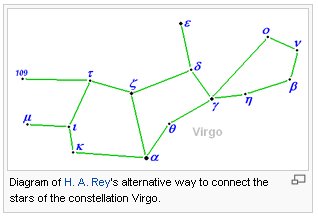Counting 12 days ahead from heliacal Spica and October 10 reaches October 22, where the Chinese would have looked for κ Virginis, but the Hindu for Arcturus. 283 (October 10) + 12 = October 22 (295). However, the creator of the C text may have looked for Syrma, like the Arabs:
Or he may have counted with glyph 280 = 20 * 29 as the important point in time, where there were no prominent stars rising together with the Sun. At first I saw a triplet of glyphs (Cb8-18--20) with the bent henua in the center - i.e. possibly a way to indicate Syrma. The design of Cb8-19 could be meant as a 'cover' of earth. Then I noticed how Metoro connected Cb8-19 with Cb8-20, making it harder to see Cb8-19 in a central position. And then 20 * 29 together with no heliacal stars (worthy of mentioning) evidently had to be taken into account. April 20 (110) coincides with 2h (30.4) and October 20 (293) with 14h (213.1). Syrma (ι) and κ Virginis are close not only in time but also in space, they are stars adorning the train on the robe of Virgo (probably Mother Earth). A dress (puo) is a cover and to dress the earth is also to cover (ata puo):
The bent henua (earth) in Cb8-19 could illustrate a shell (another type of covering) for protecting life. Together with te vai noho (dwelling in the water) at Cb8-16 the pair of nuku (crowd) glyphs could possibly refer to how at the beginning of time Raven found people crowded inside shells - first a giant bivalve clam on the beach for the males and then giant chitons in the sea for the females:
... Raven began to search for the girls. For it is the way of things in the world that there are both males and females of every creature. Somewhere there must be girls. Raven searched and searched. Under logs and behind rocks, he looked. But he could not find the hiding place of the first girls. But as he searched, the tide was going out, and as it reached its lowest, the Raven spotted some giant Chitons clinging to the rocks. These giant shell fish had but one shell, fastened tightly to the rocks with huge soft lips around their edges. Raven pried one loose with his beak. And there inside was a girl. He pried off another, and another, and another in each was a girl. They were very similar to the creatures he had found in the clamshell, but more like the Chiton, softer and rounder, in contrast to the hard shell and strong muscles of the clam. And these were just as frightened of the Raven. He gathered them onto his back with difficulty, and brought them to the boys he had found in the clamshell ... | ||||||||||||||||||||||||||||||||||||||||||

